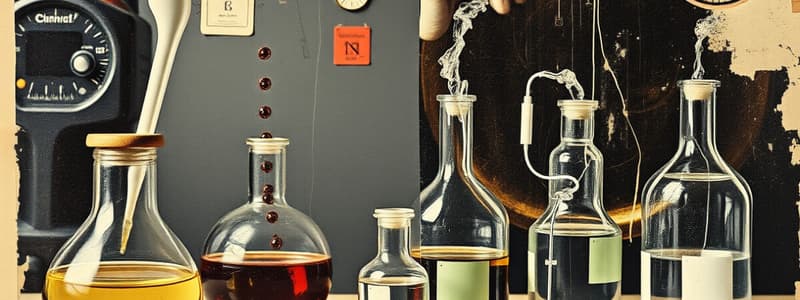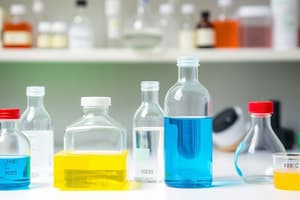Podcast
Questions and Answers
What should you do if you notice unsafe conditions in the laboratory?
What should you do if you notice unsafe conditions in the laboratory?
- Wait until the end of the lab to report.
- Notify the instructor immediately. (correct)
- Ignore them and continue working.
- Fix the issue yourself before reporting.
Which of the following is NOT a requirement when handling sharp instruments?
Which of the following is NOT a requirement when handling sharp instruments?
- Always cut towards your body. (correct)
- Grasp instruments only by the handles.
- Carry instruments with tips pointing down.
- Do not attempt to catch falling instruments.
What is the primary purpose of using a fume hood in the laboratory?
What is the primary purpose of using a fume hood in the laboratory?
- To store chemicals safely.
- To ventilate harmful vapors and maintain safety. (correct)
- To heat substances safely.
- To provide a workspace that prevents accidents.
Why is it important to sign the safety contract before participating in laboratory activities?
Why is it important to sign the safety contract before participating in laboratory activities?
What is the consequence of mixing chemicals in sink drains?
What is the consequence of mixing chemicals in sink drains?
What is the primary safety protocol regarding personal attire in the laboratory?
What is the primary safety protocol regarding personal attire in the laboratory?
How should accidents or injuries be reported in the laboratory setting?
How should accidents or injuries be reported in the laboratory setting?
What actions should be taken if a chemical splashes into the eyes or on the skin?
What actions should be taken if a chemical splashes into the eyes or on the skin?
What should students do before starting any experiment in the laboratory?
What should students do before starting any experiment in the laboratory?
What is the protocol regarding the use of food or beverages in the laboratory?
What is the protocol regarding the use of food or beverages in the laboratory?
Flashcards are hidden until you start studying
Study Notes
Purpose of the Science Laboratory
- Prioritize safety in science classrooms for students, teachers, and parents.
- Hazards include the use of hazardous chemicals in hands-on laboratory activities.
- Familiarity with the locations of safety equipment such as first aid kits, eyewash stations, safety showers, fire extinguishers, and fire blankets is crucial.
Safety Rules Overview
- Signing a student safety contract is mandatory for participation in laboratory activities.
- Maintain awareness of surroundings and report unsafe conditions to the instructor immediately.
Clothing and Personal Safety
- Proper attire is essential; secure long hair, avoid dangling jewelry, and ensure clothing is fitted.
- Closed-toe shoes are required; sandals are prohibited. Lab aprons must be worn during experiments.
Chemical Safety and Handling
- Wear laboratory goggles whenever handling chemicals, heat, or glassware—no exceptions.
- Dispose of chemical waste correctly; do not mix chemicals in sink drains.
- Use the fume hood for working with volatile substances; do not place your head in the fume hood.
General Laboratory Conduct
- Responsible behavior and adherence to instructions are essential; never work alone in the lab.
- Do not consume food or beverages, touch equipment, or engage in unauthorized experiments.
- Keep hands away from face while using chemicals and wash hands thoroughly after experiments.
Accidents and Emergencies
- Report all accidents or injuries, no matter how minor, to the instructor immediately.
- Know emergency procedures: yell "Code one" for immediate help and use eyewash stations or safety showers as needed.
- In case of broken mercury thermometers, notify the instructor and follow proper clean-up procedures.
Lab Procedures
- Read all labels and instructions carefully before using equipment and chemicals.
- Ensure all work surfaces and equipment are cleaned and returned to storage in working order after use.
- Experiments must be monitored closely, staying at assigned workstations to avoid distractions.
Studying That Suits You
Use AI to generate personalized quizzes and flashcards to suit your learning preferences.




